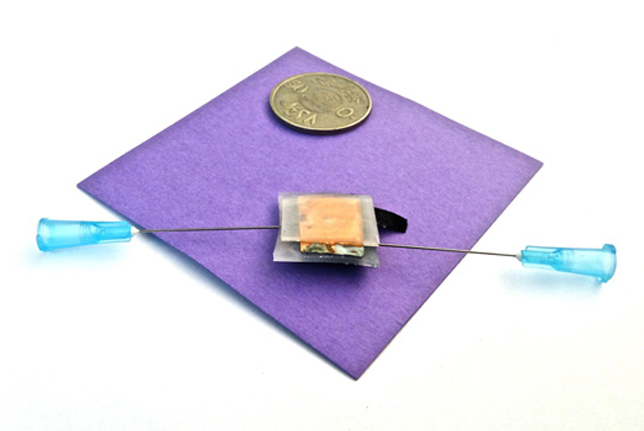Saliva-powered microbial fuel cell provides power generation source

Prof. Muhammad Mustafa Hussain and team's saliva-powered microbial fuel cell is displayed for size next to a Saudi 50 halala coin.
"Clean water is a necessity for a sustainable future," says KAUST Associate Professor of Electrical Engineering Muhammad Mustafa Hussain. "However, with the growing global population, the water crisis is increasing. Current water purification technologies are energy-intensive to use, and the countries which will face water shortages in the future will also have to face a huge power requirement to obtain clean water." Prof. Hussain's Integrated Nanotechnology Lab research group has been investigating a complementary and unique solution to this energy challenge: microbial fuel cells (MFCs).
MFCs are miniature power generators in which are contained electrogenic bacteria that consume waste and release electrons. "If these electrons are collected properly, they make the cell self-powered or self-sustained," Prof. Hussain explains. "However, the challenge of these devices is that they are still lab-based, and it can take many months to get a performance analysis of the incremental improvement of the device. Using a micro-version of the MFCs which uses a readily available fuel source provides an interesting opportunity to expedite these analyses."
In a paper recently published in NPG Asia Materials (doi: 10.1038/am.2014.1), Prof. Hussain's group, including former PhD student Justine Mink (class of 2013), showed power generation from human saliva using a micro-MFC. The 25-μl MFC was produced using graphene as an anode to produce efficient current generation, and with an air cathode to make the entire device freely mobile.
"Power generation from our MFC is significant because such small-scale power generation devices can be easily integrated into lab-on-chip or portable point-of-care diagnostic devices to power them," explains Prof. Hussain. "Such simple devices fueled by the organic material in saliva or other waste liquids provide a novel and amazing way to serve humanity by enabling the rapid dissemination of advanced healthcare technologies to dangerous or difficult to reach areas."
The researchers were surprised to discover that the use of saliva could generate a large amount of power. The MFC produced higher current densities (1190 A m-3) compared to any previously produced air-cathode micro-MFC, and the graphene anode produced 40 times more power than through the use of a carbon cloth anode. The group found that the high power generation was produced by the large amount of organic material in saliva, demonstrating a linear relationship between the organic loading and current.
"We hope that our study will cause the scientific community to think 'outside the box' for different uses of MFCs," says Prof. Hussain. "In the past, MFCs have been explored only as possible options for alternative and energy-efficient water purification technologies, but in the past three years, my group has established that other interesting opportunities and uses exist for these devices."
Prof. Hussain's group is currently investigating the use of MFCs for dialysis applications, and as sensors and illness detection devices for advanced healthcare. "Our work is a wonderful step towards a sustainable future through the use of a multidisciplinary approach involving the semiconductor industry's state-of-the-art technology, environmental science and engineering, and biochemistry," he says. "It shows that, once again, engineering can help overcome fundamental scientific challenges and provide important solutions to issues affecting the global community."

